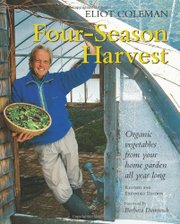Now that you are either tending or contemplating a fall garden for freshly grown, organic crops, you might consider four-season farming for year-round food. If the weather cooperates, it can be fairly easy—and can be done even in the urban setting of a small yard or next to a patio.
Today, because of industrial agriculture, we think that farming is all done out in rural areas and large tracts of land, but that actually is counter to historical fact.
In America's cities across the land prior to the mechanization of farming following World War II, small plots of land were located throughout population centers—complete with chickens and livestock! This was common in most urban areas globally. For example, Paris at one time devoted 6 percent of land to food production and produced 100 percent of its fresh vegetables.
One of the more popular methods of growing during winter was to heap horse manure and then build an enclosed structure on top of it for growing. Called a "hot house," the removable top kept vegetables protected from the elements while the decaying manure provided heat from below.
Today, horse manure in cities is no longer an abundant, cheap source of soil fertility. Moreover, for health reasons regarding soil and plant contamination, I wouldn't recommend trying to recreate such methods using uncomposted manure as a heat source without thorough study of safe designs. However, modern urban farmers—as well as homesteaders, suburbanites and rural folks wanting easy access to homegrown food—can nearly match that production by using cold frames.
Simply stated, a cold frame is a box similar to a 4-foot by 8-foot "Jim's plot" but has a removable, clear glass or plastic top. Consider it a mini-greenhouse. Just make sure to vent the top during the day. At night, keep the cold frames closed, and they'll retain heat.
Cold frames can be simple DIY projects, such as planting between a few square bales of hay and recycling old windows or shower doors as the removable tops. You can also purchase pre-made kits from local garden stores or online.
You can build a cold frame anywhere; just make sure it has southern sun exposure. Even a small frame can produce a lot of leafy vegetables if you correctly prune them: Pick old leaves first, in effect pruning the plant so that its energy goes into new leaves.
If you have more space, here's another option using the same principle that can contain more crops. Hoop houses, also called high tunnels, work by using layers of plastic to trap warmer daytime air inside and minimize heat loss from the system at night. They don't have to be big or towering affairs. You can bend plastic pipes over metal rebar spikes pounded into the ground and cover them with plastic.
Hoop houses can range from small tunnels—perhaps 3 feet tall and any length you prefer—to large edifices that you can make portable with wheels. You can even pull them with a tractor to rotate crops.
For more information on hoop houses, visit msucares.com/crops/hightunnels/index.html.
Growers in Mississippi who use high tunnels will be meeting to share tips at the Mississippi Fruit and Vegetable Growers Association and the Mississippi Agritourism Association conference in Jackson Nov. 28-29 at the Hilton Hotel on County Line Road. For more info, visit msfruitandveg.com or email [email protected]. You can also contact Candi Adams at 662-534-1916 or [email protected].



Comments
Use the comment form below to begin a discussion about this content.
comments powered by Disqus